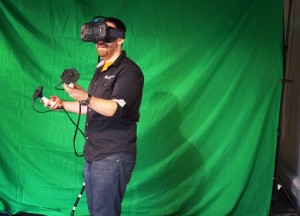Cloudhead Games’ ‘Blink’ to Bring Nausea-free VR to HTC Vive this Holiday
 [Philip Lelyveld comment: they avoid simsickness by teleporting you. Essentially, they use jump cuts to avoid simsickness. The truly valuable solutions involve addressing latency, persistence, focus/vergence conflict, and other visual system issues.]
[Philip Lelyveld comment: they avoid simsickness by teleporting you. Essentially, they use jump cuts to avoid simsickness. The truly valuable solutions involve addressing latency, persistence, focus/vergence conflict, and other visual system issues.]
VR hardware is improving and the display techniques such as low persistence of vision, pioneered by Oculus and Valve over just the last couple of years mean perceiving VR imagery inside VR headsets is a whole lot more comfortable these days.
The Oculus Rift DK2 brought us optical positional tracking, freeing our heads and bodies from a purely rotationally tracked virtual world. The system allowed free movement within the confines of the tracking camera’s FOV, which when positioned correctly was relatively generous. The HTC Vive and its Lighthouse laser tracking system expanded upon that freedom, introducing what they termed ‘room scale’ tracking – pitching their VR system as one you could explore both physical and virtual spaces with.
Essentially, your inner ear disagrees with your brain – you’re moving in virtual space but not in physical.
Subtitled ‘Elastic VR Playspace’ the solution comprises a number of techniques (as outlined in the video above, presented by Cloudhead Games’ Denny Unger) which, when combined tackles all of the above issues: Cinematic Blink, Precision Blink and Volume Blink – a “locomotion mechanic which ensures player safety, deep traversal and complete spacial awareness in both the virtual and real world.”
Essentially, Blink employs a point, click and teleport system which removes the uncomfortable elements of virtual travel by snapping you to a position and orientation defined by you instantly thereby essentially sidestepping the issue.
See the full story here: http://www.roadtovr.com/cloudhead-games-blink-to-debut-nausea-free-vr-on-htc-vive-this-holiday/
Pages
- About Philip Lelyveld
- Mark and Addie Lelyveld Biographies
- Presentations and articles
- Tufts Alumni Bio